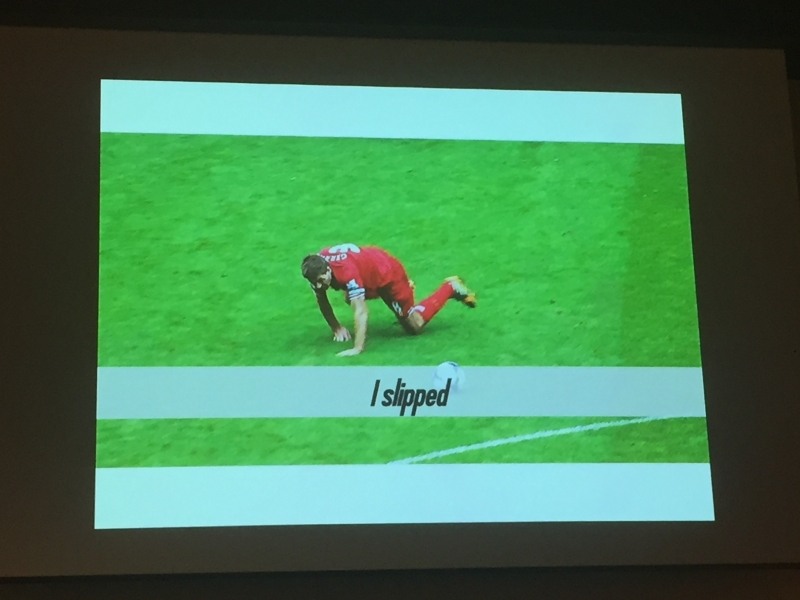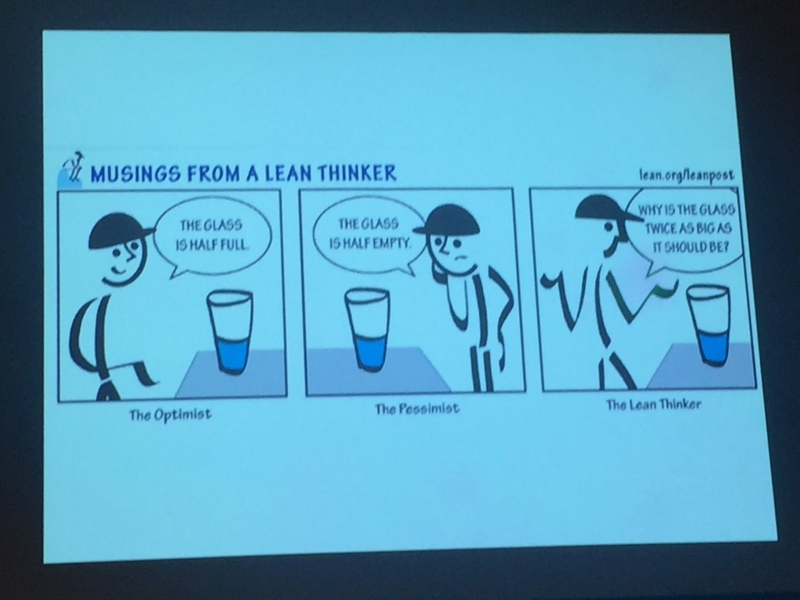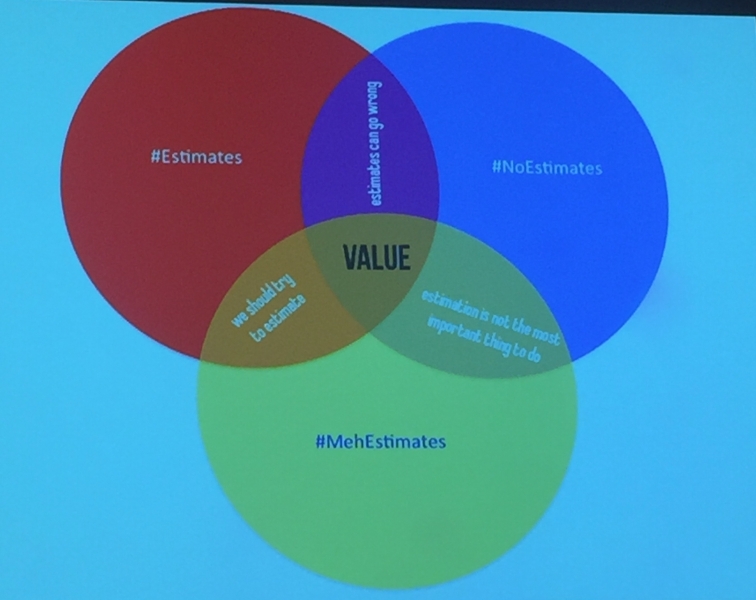Agilia Conference 2016 was held in Olomouc.
I will summarize my notes bellow. Sometimes these are quotes, sometimes these are ideas they emerge in my mind. Hard to say, but they are always connected with the particular speech.
Day 1
Tom Gilb – Value Planning in a Lean and Agile way
Excellent starting keynote from Tom about stopping bullshits.
- Values need to be set quantitatively to have hard numbers -> No more management bullshits
- Everything can be managed in a simple way by focusing on the most important things only.
- Find 10 most critical things.
- Quantify them (past + goals)
- Measure – are we going towards them?
- Count a number of ambiguous words in each management talk = level of bullshit
- Use meta language for goals description
- Large projects have huge number of stakeholders
- Stakeholder is anybody who expects the value or has some interest or even can be affected
- There are complex relations between stakeholders -> map them
- Scrum is too primitive for complex business
- Scrum has 19% of fail and they are proud of it. What if you are a doctor? Hey, I just finished 4th surgery. You are the next.
- Primary goal of Agile manifesto its deliver the code. It started the revolution, but the aim should be to deliver the value
- Burndown should be based on delivered value not the code
- Do not pay for the work. Pay for the value.
- One is different from zero. If we deliver at least 1% of the value every week, we are on the track. Than the pace is up to discussion. If you deliver zero, than pace is out of the table.
- Accenture’s goal is to milk government from all tax money you paid. But it is not their fault. We are foolish to allow it because we struggle to measure delivered value.
- What about contracts based on the value?
- Let critical stakeholders to decide about critical requirements.
Catalin-Teodor Dogaru – Servant – Leadership: The Power of Leadership Through Service!
In my opinion this was quite known topic served in quite general way without any real live examples from software development area to based the story on.
- Aristoteles: “Serve others and do good”
- If you want to go fast go alone
- If you want to go far go together
- You had some idea deep in your mind. I reminded it to you and now you hate me because you are again thinking about it
Adam Mitchel – DSDM / Agile Teams
This was a bit disappointment for me. I was expecting the practical speech explaining why DSDM was the best choice in this case but it was only about a success story with no details, comparison, what-if, etc.
- Why Agile? It is still a valid question.
- You need a good mix of extroverts and introverts
Ahmad Fahmy – Retrospective – On a three year large scale agile adoption
Great topic, great speaker. I liked that.
- There is a need -> There is a team -> There is a purpose -> Then it works
- Success = purpose + autonomy + mastery
- Small projects have 32% better chance to succeed with Agile than with Waterfall. Huge projects has 600% better chance. In average it is about 350%.
- When you ask IT person “Who are you?” they will answer by the job role. Nobody really answer “I am Mike. I like this and this…”.
- The first step is to unfreeze your organization. Than introduce the change. Later freeze it after it is adopted
- Component is not a feature. Build your teams around features, not components
- Agile adoption should start with organizational and business changes, not with the teams and technical knowledge
- Business people are not used to transparency
- Transparency leads to frustration
- You will loose velocity by adoption of Agile due to learning. Expect it. It will go up eventually
- Do not scare everybody. Do it per pieces.
- Adoption does not equal transformation
- If you have release sprint you are still in waterfall mindset
- Manager: “How long is this Agile adoption going to take?” Is not this a typical waterfall question?
- You would like to refactor the process rather to do it from scratch. There is no difference from coding.
- Others want you to fail if you are changing something they are used to
- You can never solve all problems
- Middle level of management is key to success. C-level is too high, team members are too low. Middle level of management typical grows up from team members so they have the real life experience and they have the power.
- People are motivated by the need to feel important
Anna Zarudzka – Scrum allows us to create better products, more suited to the users’ needs. Really???
I was expecting some sarcastic and provocative speech. Huge disappointment. It had no clear structure, there was no clear take a way. Topic was for 10 minutes and rest was combination of cliche and repeating what was already said. Reading from slides? Really?
- If you keep asking you get new answers
- After how many sprints do you forgot about the product vision?
- Patients are wrong almost any time when they go to the doctor with their diagnosis. Who is a doctor and who is the patient? Every time when doctors do not listen to the patient they are wrong in the diagnosis.
Jovan Vidić – You are messing up with people’s lives – From burnout to #NoEstimates
This was the best talk for me. Probably because I was very close to burnout recently. I also liked the slides.
- When estimates starts with “IF”…
- There are always to options “I can work more” or “You want more? Good luck, but without me. When enough is enough”
- Not having roles is based on wider knowledge then activities are not compromised
- There should not be an approval need for refactoring
- When you have all people with 5+ years of experience you need to deal with a lot of strong opinions
- Predictability does not equal estimating
- Limiting WIPs leads to deliver more
- Groups do not thing, people do
Milena-Mercedes May – Beyond agile teams – improving the company with agile methods (Lessons Learned)
It was her first speech on a conference ever so I am ok with the presentation skills. Actually they were quite good in this case. However I did not learned anything new. Future Fridays working on something internal, or in general on anything you want??? It is nothing new. Sad is that it is still not a common practice.
- Emerge is the word
- There is a huge difference between cooperation and collaboration
Day 2
Scott W. Ambler – Disciplined Agile Delivery (DAD)
Good keynote. Guite general but well structured and in the flow. Clear message.
- Think out of the box, even out of the box of Agile
- We are really good in building the race engines and tuning them. But then we put them into the organizational’s tractor
- I can buy a race car, but it does not mean I can win a race
- Target is to win a race not to tune the engine
- Empiricism is far more important then theory
- Hybrid frameworks based on wide experience are good
- There is an incredible wasting of money in it. We are still discussing topics we were discussing 15 years ago and we will probably discuss them for the next 15 years
- But how does it fit together?
- What is going out in the field is often very different from what gurus are saying it is happening
- Context matters
- Teams are composed from unique individuals. Even identical twins spend a lot of time defending they are different
- Context of the team = Size + Distribution + Compliance + Domain complexity + Technical Complexity
- Working in cubes means working in distributed teams – if you need to walk more than a few meters, there is a fair change you gonna be lazy and you will send an email instead of it
- You can be as Agile as you possibly can be in your context if you choose to be
- Traditional folks are not good in dealing with complexity
- Repeatable results are far more important than repeatable process
- Repeatable processes are very close to bureaucracy
- Even managers do not believe in estimates and budgets. Ask them after several beers.
- Choices are good. Making informed choices is better. That is why “It depends” answer really makes sense
- All delivery teams need similar capabilities but perform then in different ways
- May be you really nee 1000 pages long requirements before you can start. May be.
- Define the decision tree -> Find where you are -> Understand why -> Discuss trade offs (because there is nothing like a best practice) -> Pick up and choose -> Continuously adopt -> Hopefully in right way
- Agile does not subscribe receipts
- Software development is complex, that is why we are paid as we are
- Different teams have different learning experience even following the same process
- How can I be the best me? -> How can I help the team? -> How can I help the organization -> How can I give back to community
- Optimize the flow, not artifacts
- Different software religions need to find the way how to work together otherwise we are going to kill each other
- You need to master walking before you start running
Matteo Taddei – How to Write Effective Requirements in an Agile Environment
Talk about the basics of user stories. Could be interesting if you never heard about them.
Anthony Montgomery – Zeros to Heroes in Just Three Months: When Capability is Your Product
Quite interesting topic about Agile adoption in non IT environment. This is a great idea and the great opportunity. Talk was well structured but everything looked to good. I would rather see the example where there were some challenges, wrong decissions, learnings, etc.
- If you could choose only the one super power, what it would be?
- Building the skyscraper is complex but there is a low uncertainty
- Business tends to underestimate gain of productivity
- Efficiency = “More work for the same cost” or “The same amount of work for the less cost”
- Agile application in business often starts on the green field
Jakub Szczepanik – Road of the Scrum Master
This was a substitution for another speech so I can understand it was kind of ad-hoc. However I really did not like it. This was really bad. No structure, chaotic presentation, only basics and I also disagree with some key points. I left after 20 minutes to join the parallel track. I returned for the last few minutes and that makes me almost angry = “You should have also personal time trainer.” Sorry but I am not a sheep.
Felice de Robertis – Product Owners of Extremely Scaled Agile
Another strange speech which makes me sad. There was not any take away. Reading slides. Most common world was “So, so, so”. Only very few ideas I pointed down
- If you are a product owner on a single team what is your responsibility against the others
- Bad product owners become the person who only writes the user stories
Evan Leybourn – If you need to run a project you have already failed
Excellent. This was on the level of keynote. Provocative, clear message, perfect flow. Amazing.
- I know they are exceptions
- Project = temporary govern to deliver something
- We need to deliver continuously. But if the project is temporary it cannot continue by definition
- If everything around us is continuous why the hell we are planning and running the projects focusing on it’s end
- Project costs money
- Overheads are sometimes the biggest part of budget
- We measure a lot of things but measuring doe not make them valuable
- We need constrains but we need to agree with them
- Outcome does not equal output. Start with them because outputs really do not matter if you deliver the outcome
- Do not ask “How much will it cost?” rather ask “How much is it worth?”
- When you understand the outcome you need a dedicated functional team that contains the required skills to deliver an outcome when output really depends on the team and they are accountable for it
- Use activity canvas
- Empower the team to decide about output. They are the experts in it. You are not
- Value degrades when you lose focus on outcome because you already an output
- Sometimes you need to remove functionality to increase the value
- So what? Nominate somebody as Devil advocate for each activity to always disagree
- If you want to be agile partner with your clients you really need to ask the question “How much is it worth?”
- If your customer does not trust you you cannot to be in partner relationship -> you cannot do Agile with them
David Farley – Farley’s Laws
Good closing keynote. More about psychology, science, mind, brain, etc.
- The world makes more sequence as soon as you realize that most people do not know what they are doing
- Law 1 = People are crap
- Law 2 = Stuff is more complicated than you think
- Law 3 = All stuff is interesting
- We are not so good we think we are
- Seeing is believing but it is matter of perspective
- Believe comes easily. Doubt takes effort
- Software development is incredibly hard thing to do. Should not we apply more science if the science is collection of the best humanity came with?
- You must not fool yourself is the first step
- Most of the experiments go wrong and that is good
- Do not guess or cheat only because you have a previous experience
- Practice is moving from slow thinking to fast thinking
- Seek for feedback cycles. There are many mores than you think
Other thoughts
- Venue of Clarion is excellent
- Lunch was even better. Cheers to chef.
- Gill’s coffee – they were excellent last year and they are excellent this year again. The best conference coffee ever
Conclusion
My measure is that the conference is success when I like at least half of the talks I attended. Here it was exactly half-half so I am satisfied.







